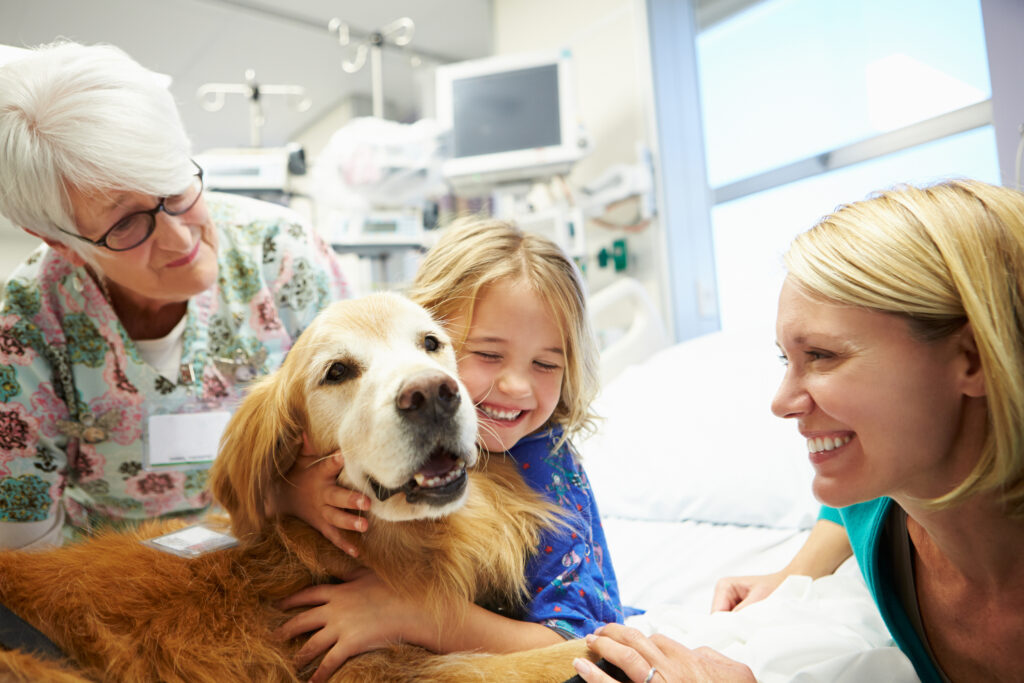In hospitals and summer camps, the handlers who volunteer at Happy Tails see that they’re making a difference. So do the dogs putting in the real work. And nothing distracts the committed canines from their jobs.
Earlier this year, a respite caregiver incessantly tried to coax Dixie, a 4-year-old mini labradoodle, to come to her for pets. But she refused to leave the terminally ill man seated in his chair.
“Dixie sat on this patient’s feet and just rested against his legs,” said Cassie Vanderhart, Dixie’s owner and treasurer of Happy Tails, a nonprofit in Georgia. “She was like, ‘I am here to visit him, not you.’ I don’t know how, and I can’t explain it. But she knows what her role is. She knows what she is doing.”
What Dixie, and scores of activity and therapy dogs do, is contribute to a decrease in levels of cortisol, commonly called the stress hormone, and an increase in serotonin, oxytocin and endorphins – hormones that engender positive feelings.
Numerous studies, reviews and clinical trials have linked those physiological responses to human interaction with dogs. Some of the conclusions are supported by quantitative evidence, which involves measuring hormone levels or recording lower blood pressure readings.
Some results are based on qualitative evidence, such as survey responses indicating mood improvement, decreased feelings of depression, or increased appetite. At other times, it’s anecdotal observations, such as what Leah Hall, president of Happy Tails, witnessed during her visit to a rehabilitation center for people recovering from surgery or a stroke. She was with her now-deceased golden retriever, Wembley.

“We walked into a room, and you could tell it was a somber moment. The patient had been sitting in a chair and maybe had been crying,” Hall said. “My dog walked up and just placed her head on her lap immediately. And (the woman) bent her head down and buried her head in her fur and was just crying and saying, “You just don’t know how much I needed this.”
That woman’s reaction to Wembley is a common one. Research teams have reported that touching and making eye contact with a dog increases oxytocin levels, according to the International Association of Animal Behavior Consultants.
Oxytocin has many nicknames – including the ‘love drug’, the ‘cuddle hormone’ and the ‘love hormone,’ according to Harvard Health. And it plays a role in social bonding and reproduction. However, it also fosters a sense of resilience during hardship and helps regulate stress levels.
Endorphins boost mood and relieve pain. A comprehensive evaluation of 16 studies that assessed animal-assisted therapy for terminally ill adults receiving palliative care found that some program participants reported feeling less pain after just one visit with a dog. Additional results included a reported reduction in emotional distress, anger and depression.
Serotonin, best known for its influence on mood regulation, also plays a significant role in digestion and appetite. A Canadian study examining the effects of animal-assisted therapy on children with cancer found that those who participated in the therapy experienced an increase in appetite during their treatment.
They also became more compliant with treatment, more open to invasive procedures, more willing to eat, socialize, express their fears and develop friendships during their hospitalization, according to observations from their caregivers.
The studies cited here all involved animal-assisted therapy. That treatment occurs under the guidance of a licensed therapist, with specific goals and measurable outcomes. Happy Tails volunteers and their dogs are available for that service, but the void they fill most often is animal-assisted activity. Those informal visits involve visiting hospitals, rehabilitation centers, nursing homes and schools to offer companionship, cuddles and a distraction from their circumstances.
Happy Tails, which is a 501(c)(3) nonprofit, receives requests for those informal visits most often. The organization regularly has a waiting list of 40 to 50 institutions, which it hopes to whittle with additional resources and volunteers.
Johns Hopkins Medicine cites the same health benefits for people who volunteer with organizations like Happy Tails or own pets as those who experience animal-assisted therapy, including an improvement in heart health.
The American Heart Association lists 16 reasons why dog ownership might benefit your health, ranging from reducing the risk of dying from a heart attack or stroke by 31% to easing people out of isolation and shyness.
The latter certainly applies to Chris White, a new Happy Tails volunteer, who says her dog, Joey, makes her feel more at ease talking to people. “I’m a classic introvert,” she said. “But I can strike up any conversation about my dog or someone else’s dog. In fact, I have a t-shirt that says, “Introverted, but willing to discuss dogs.”

During a recent Happy Tails session, a mother who participated in a Happy Tails visit wound up helping White. She’d taken Joey to Ronald McDonald House, which provides comfortable, private living quarters for families receiving medical care at hospitals in cities away from their homes.
A mother whose son recently lost a leg to amputation to slow the spread of osteosarcoma, a rare bone cancer, approached her. She noticed that Joey was missing his rear left leg, and the mother asked about his condition. Joey recently had the same surgery and terminal prognosis as the woman’s son. The mom shared details of her experience, which White found helpful as she’s striving to make Joey’s final years happy ones.
Vanderhart helped establish Happy Tails’ partnership with a local hospice. “I had a great-grandmother who was in hospice before she passed, and it was just a wonderful experience,” she said. “I often feel like I’m a vessel supporting Dixie’s life purpose, but I get so much out of it as well. “Our visits help remind me of what is important in life, which is connection and community. Our visits are uniquely human moments that I carry with me.”


